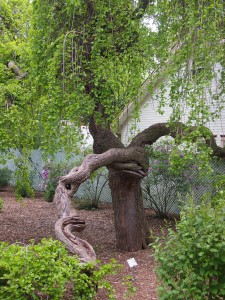 One more shot from Lilacia Park — a peculiar tree. Who doesn’t like tree trunks that splay out in different directions?
One more shot from Lilacia Park — a peculiar tree. Who doesn’t like tree trunks that splay out in different directions?
More on the story of this beflowered little park is told by Illinois Old Houses (1977) by John Drury, which this web site extracts and asserts the book is public domain. In any case, it says that “… this was the home of the late Colonel William R. Plum, pioneer resident of the village — soldier, lawyer, traveler, writer, horticulturist, and founder of Lilacia Park. Containing more than three hundred varieties of lilacs from all parts of the world, this park is regarded by botanists as the finest lilac garden in the Western Hemisphere.
” ‘In 1911, when we were on a tour of Europe,’ Colonel Plum once told a family friend, Mrs. Annabelle Seaton, ‘we stopped at Nancy, in France, and there visited the famous lilac gardens of Pierre Lemoine. That visit proved my downfall. My wife purchased two choice lilac specimens, a double white and a double purple, and we brought them back to Lombard. From that time on my enthusiasm for lilacs grew and I have never lost interest in them since.’
“When Colonel Plum made this statement, the results of his hobby could be seen all about the old Plum home. Here were all types of lilacs, including one of his favorites, a blue variety called the ‘President Lincoln.’ The shrubs were pleasingly arranged on the Plum estate of two and a half acres, which he called ‘Lilacia.’ Since expanded to ten acres, Lilacia — re-named Lilacia Park — now contains 1,500 lilac bushes as well as 87,000 tulip bulbs.”
The Abraham Lincoln variety, I noticed, is still growing on the grounds of Lilacia Park. So is one named after Gen. Pershing, but most varieties don’t involve famed Americans. As for Pierre Lemoine, he seems to be this fellow, Victor Lemoine (the Spanish version of the page gives his full name as Pierre Louis Victor Lemoine), “a celebrated and prolific French flower breeder who, among other accomplishments, created many of today’s lilac varieties.” Born 1823, died 1911, so I guess you could say he created lilacs for the Belle Époque.